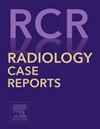Sequential Aspiration and injection of a Mixture of gelatin-based hemostatic agent and autologous blood clot followed by suture coiling for Effective Embolization of splenic artery pseudoaneurysm by interventional Radiologist (SAMEER): Description of a novel technique
Q4 Medicine
引用次数: 0
Abstract
Pseudoaneurysms of the splenic artery usually arise as a complication of pancreatitis. Due to the risk of rupture, treatment of the pseudoaneurysms of splenic artery is considered as a priority in the management of pancreatitis. While endovascular embolization is an established minimally invasive and effective technique for the treatment of splenic artery pseudoaneurysms, however, in some cases endovascular embolization may not be feasible, owing to the difficulties in accessing the distal small pseudoaneurysms or due to financial constraints. In such a scenario, percutaneous image guided direct puncture and embolization of the pseudoaneurysms is a valuable option. While most of the previous publications have reported on the use of n‑butyl cyanoacrylate, coils and thrombin for percutaneous embolization of splenic artery pseudoaneurysms, however, these agents may not be easily accessible to many health facilities in emergency situations and their cost may limit their use. In this report, we describe a novel technique of percutaneous embolization of splenic artery pseudoaneurysms with Sequential Aspiration and injection of a Mixture of gelatin-based hemostatic agent and autologous blood clot followed by suture coiling for Effective Embolization of splenic artery pseudoaneurysm by interventional Radiologist (SAMEER technique). We demonstrate the safety and efficacy of this technique in a series of 2 cases.
介入放射科医师(SAMEER)连续抽吸和注射明胶止血剂和自体血凝块的混合物,然后缝合卷取,用于有效栓塞脾动脉假性动脉瘤:一种新技术的描述
脾动脉假性动脉瘤通常是胰腺炎的并发症。由于脾动脉假性动脉瘤有破裂的危险,治疗脾动脉假性动脉瘤被认为是胰腺炎治疗的优先事项。虽然血管内栓塞是一种微创且有效的治疗脾动脉假性动脉瘤的技术,然而,在某些情况下,由于难以进入远端小假性动脉瘤或由于财政限制,血管内栓塞可能不可行。在这种情况下,经皮图像引导下直接穿刺和栓塞假性动脉瘤是一个有价值的选择。虽然以前的大多数出版物都报道了使用氰基丙烯酸酯正丁酯、线圈和凝血酶经皮栓塞脾动脉假性动脉瘤,但是,在紧急情况下,许多卫生机构可能不容易获得这些药物,而且它们的成本可能限制了它们的使用。在这篇报道中,我们描述了一种新的经皮脾动脉假性动脉瘤栓塞技术,通过连续吸入和注射明胶基止血剂和自体血凝块的混合物,然后缝合卷取,以有效栓塞介入放射科医生的脾动脉假性动脉瘤(SAMEER技术)。我们在一系列的2例病例中证明了这种技术的安全性和有效性。
本文章由计算机程序翻译,如有差异,请以英文原文为准。
求助全文
约1分钟内获得全文
求助全文
来源期刊

Radiology Case Reports
Medicine-Radiology, Nuclear Medicine and Imaging
CiteScore
1.10
自引率
0.00%
发文量
1074
审稿时长
30 days
期刊介绍:
The content of this journal is exclusively case reports that feature diagnostic imaging. Categories in which case reports can be placed include the musculoskeletal system, spine, central nervous system, head and neck, cardiovascular, chest, gastrointestinal, genitourinary, multisystem, pediatric, emergency, women''s imaging, oncologic, normal variants, medical devices, foreign bodies, interventional radiology, nuclear medicine, molecular imaging, ultrasonography, imaging artifacts, forensic, anthropological, and medical-legal. Articles must be well-documented and include a review of the appropriate literature.
 求助内容:
求助内容: 应助结果提醒方式:
应助结果提醒方式:


